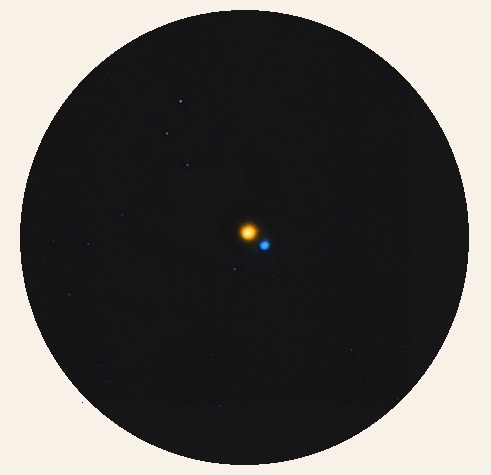Beginner's Guide
The Stars
Naming the Stars
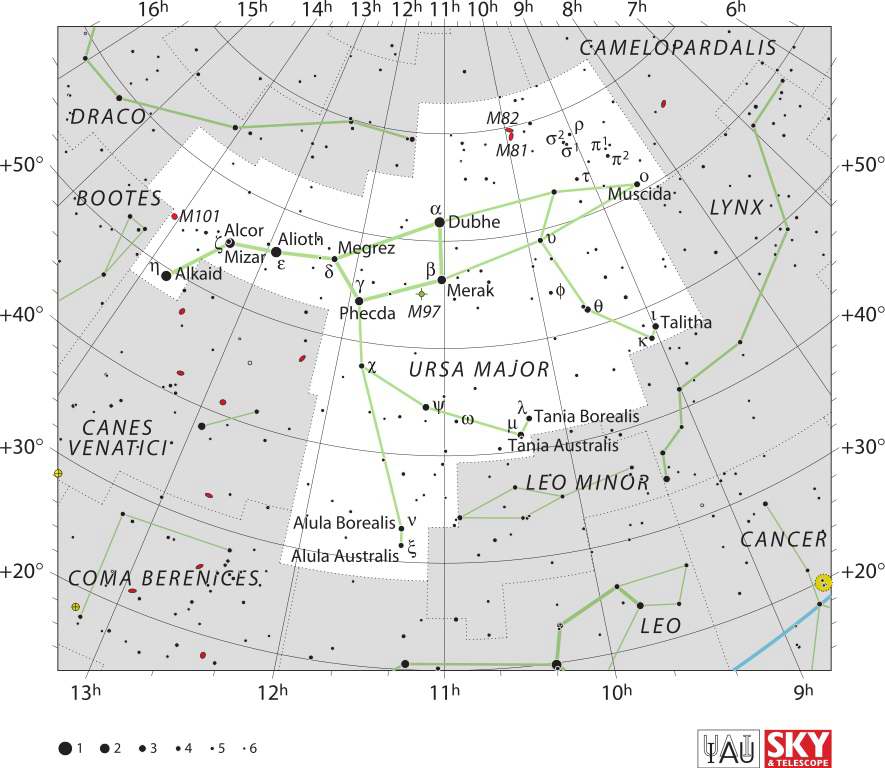 There are 3 major ways stars are named: proper name, Bayer designation, and Flamsteed designation. But for a handful of stars, they also
have informal names. The one you've probably heard of is the North Star. It's proper name is Polaris, the Bayer designation is
α Ursa Minoris, and the Flamsteed designation is 1 Ursa Minoris.
There are 3 major ways stars are named: proper name, Bayer designation, and Flamsteed designation. But for a handful of stars, they also
have informal names. The one you've probably heard of is the North Star. It's proper name is Polaris, the Bayer designation is
α Ursa Minoris, and the Flamsteed designation is 1 Ursa Minoris.
Proper Names
Proper star names are straightforward. For example, the brightest star in the sky is Sirius. Another one you might have heard is Betelgeuse. Look at the figure at the right of the constellation Ursa Major which contains the seven stars of The Big Dipper. Each of those stars has a proper name: Dubhe, Merak, Phecda, Megrez, Alioth, Mizar, and Alkaid. But there are a lot of stars in the sky, almost 10,000 stars are visible to the naked-eye! This presents several problems: 1) we have to come up with names, 2) it's hard to keep any of these stars even remotely memorized, and 3) it's hard to put them on a star atlas for the sheer amount of space they take up. Is it important to know all those names? No, except for the very brightest stars in the sky. And we have other more convenient ways to name them.
Bayer Designation
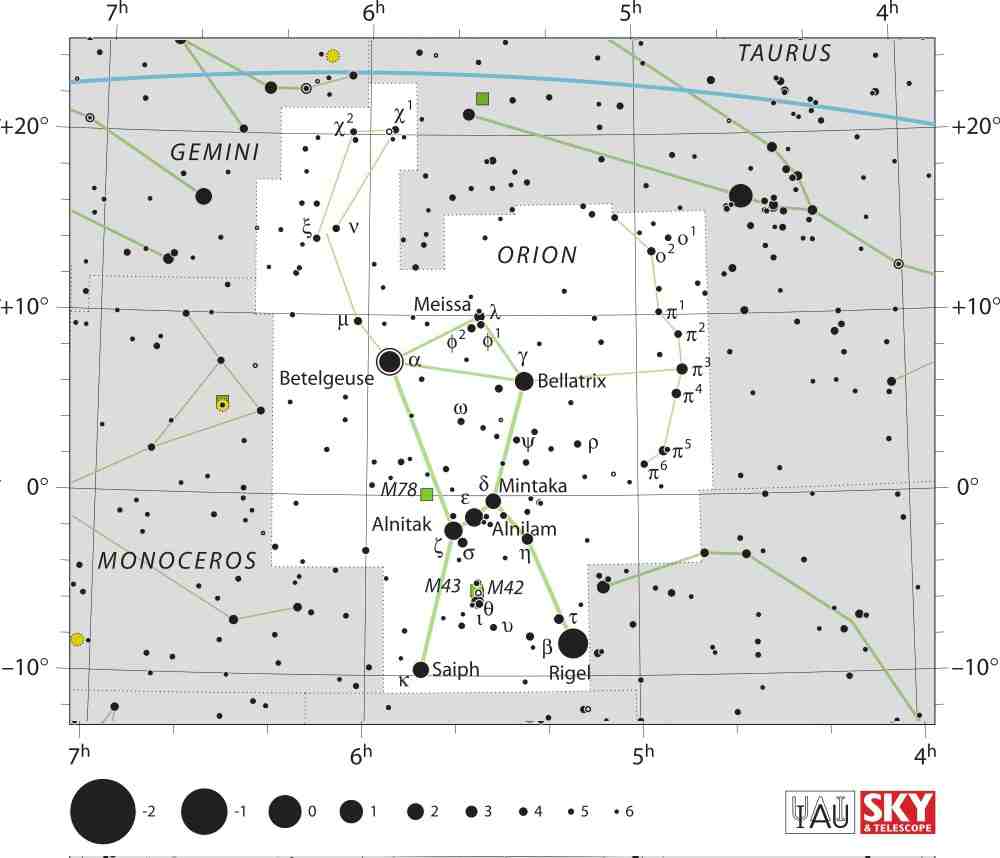 You will often see Greek letters used on star atlases to indicate stars. They use the lower case
Greek alphabet: α, β, γ, δ,
ε, ζ, η, θ, ι, κ, λ, μ, ν, ξ, ο, π, ρ, σ, τ, υ,
φ, χ, ψ, and ω. These letters get appended with the given constellation. For example: the first star in the Big Dipper has the
proper name of Dubhe. The Bayer designation is α Ursa Majoris. The second star, Merak is β Ursa Majoris, and so on. You should be able
to immediately see this saves space on an atlas. If more letters are needed, the Bayer system then goes to A, b, c, d, ... (Small "a" is not used
because it could be confused with α.
You will often see Greek letters used on star atlases to indicate stars. They use the lower case
Greek alphabet: α, β, γ, δ,
ε, ζ, η, θ, ι, κ, λ, μ, ν, ξ, ο, π, ρ, σ, τ, υ,
φ, χ, ψ, and ω. These letters get appended with the given constellation. For example: the first star in the Big Dipper has the
proper name of Dubhe. The Bayer designation is α Ursa Majoris. The second star, Merak is β Ursa Majoris, and so on. You should be able
to immediately see this saves space on an atlas. If more letters are needed, the Bayer system then goes to A, b, c, d, ... (Small "a" is not used
because it could be confused with α.
You will also see Bayer Designations with the addition of a numeric superscript. One example is θ Sagittarii. To the naked-eye it appears as a single star, but with any optical aid it shows it to be two stars. So one became θ1 and the other θ2 Sagittarii. But as you see with the case of Orion they were used simply because this constellation had many more conspicuous naked-eye stars than 24 Greek letters could accommodate. As you can see in the diagram above there's π1 - π6, ο1 & ο2, and χ1 & χ2.
Note: You can also use the 3 character constellation abbreviation. So α Ursa Majoris = α UMa.The abbreviations are often used because of their convenience. You can find a table of constellations with those abbreviations here.
 In general the stars of any given constellation are assigned Greek letters in descending order of brightness. So the brightest star in a constellation would
be labeled α, the next brightest β, etc. Though this general rule is pretty good, there are some exceptions. Ursa Major is a good example where
the stars of the Big Dipper are assigned in order: α - η without regard to overall brightness.
Another example is
Betelguese in the constellion Orion is labeled α Orionis, but Rigel (β
Orionis) is actually brighter.
In general the stars of any given constellation are assigned Greek letters in descending order of brightness. So the brightest star in a constellation would
be labeled α, the next brightest β, etc. Though this general rule is pretty good, there are some exceptions. Ursa Major is a good example where
the stars of the Big Dipper are assigned in order: α - η without regard to overall brightness.
Another example is
Betelguese in the constellion Orion is labeled α Orionis, but Rigel (β
Orionis) is actually brighter.
Greek Alphabet
| Upper | Lower | Name | Pronounced * |
|---|---|---|---|
| Α | α | Alpha | AL-fah |
| Β | β | Beta | BAY-tah |
| Γ | γ | Gamma | GA-mah |
| Δ | δ | Delta | DELL-tah |
| Ε | ε | Epsilon | EP-sill-on |
| Ζ | ζ | Zeta | ZAY-tah |
| Η | η | Eta | AY-tah |
| Θ | θ | Theta | THAY-tah |
| Ι | ι | Iota | eye-OH-tah |
| Κ | κ | Kappa | CAP-ah |
| Λ | λ | Lambda | LAM-dah |
| Μ | μ | Mu | MEW or MOO |
| Ν | ν | Nu | NEW |
| Ξ | ξ | Xi | ZIE |
| Ο | ο | Omicron | OH-ih-cron |
| Π | π | Pi | PIE |
| Ρ | ρ | Rho | ROW |
| Σ | σ | Sigma | SIG-mah |
| Τ | τ | Tau | TAW |
| Υ | υ | Upsilon | UP-sih-lon |
| Φ | φ | Phi | FIE |
| Χ | χ | Chi | KIE |
| Ψ | ψ | Psi | SIGH |
| Ω | ω | Omega | OH-may-gah |
Flamsteed Designation
Flamsteed designations are the third major way of labeling stars in a constellation. They are usually referred to as Flamsteed numbers because this system only uses numbers and every constellation starts with the number 1. Unlike Bayer designations which are assigned generally in brightness order, Flamsteed goes in order of Right Ascension. On a star atlas you probably will see few Flamsteed numbers. That is because even though every naked-eye star in a constellation has a number, atlases generally use Bayer designations when available.
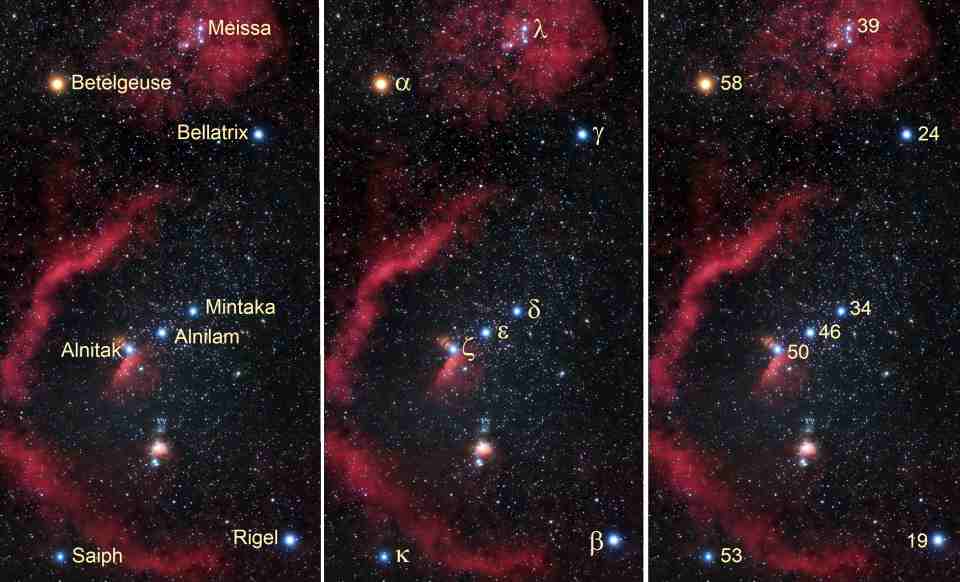
3 images of the constellation Orion. The left panel showing proper names, the middle Bayer Designations, and
the right Flamsteed Numbers.
Miscellaneous Designations
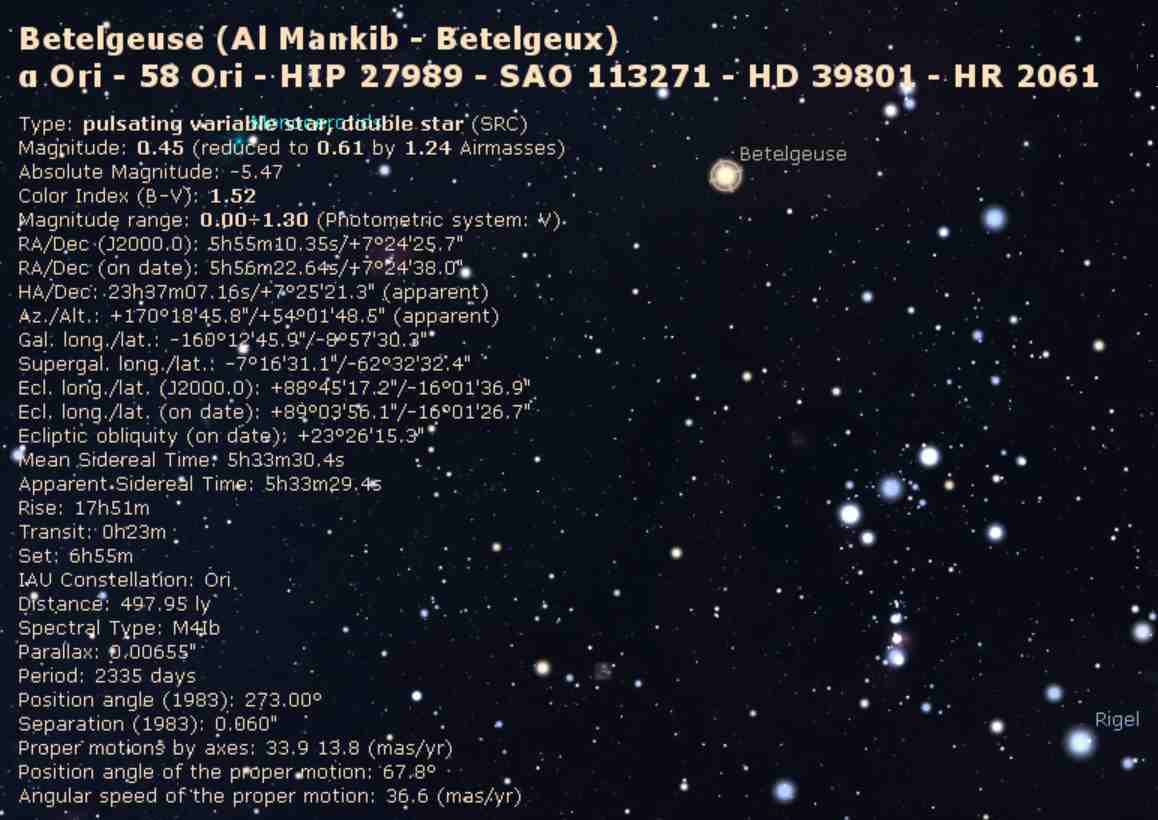 Variable stars have their own naming convention which will be discussed below. And there are other catalogs which have cropped up over time as
binoculars and telescopes greatly increased the number of visible stars. At the right you see a Stellarium screenshot of Orion with Betegeuse
highlighted so it shows that star's info. The top line shows the common proper name and two alternative proper names. The second line shows
the Bayer Designation (α Ori), Flamsteed Number (58 Ori),
Hipparcos Catalog (HIP 27989),
Smithsonian Astrophysical Observatory Catalog
(SAO 113271),
Henry Draper Catalog (HD 39801), and the
Bright Star Catalogue (HR 2061).
Variable stars have their own naming convention which will be discussed below. And there are other catalogs which have cropped up over time as
binoculars and telescopes greatly increased the number of visible stars. At the right you see a Stellarium screenshot of Orion with Betegeuse
highlighted so it shows that star's info. The top line shows the common proper name and two alternative proper names. The second line shows
the Bayer Designation (α Ori), Flamsteed Number (58 Ori),
Hipparcos Catalog (HIP 27989),
Smithsonian Astrophysical Observatory Catalog
(SAO 113271),
Henry Draper Catalog (HD 39801), and the
Bright Star Catalogue (HR 2061).
There are two other catalogues we will mention. The first is the Guide Star Catalog (GSC-I) which was compiled for the Hubble Space Telescope. The catalog contains almost 20 million stars. It was later updated (GSC II) and now contains almost one billion stars. The second is the Sloan Digital Sky Survey (SDSS).
Star Brightness Scale
The brightness of stars and other celestial objects are measured by magnitudes. We call this apparent magnitude because these are the brightness as seen from Earth. The premise of the system was introduced in ancient Greece where the brightest stars were magnitude 1 and the faintest stars that could be seen naked-eye were magnitude 6. That was obviously not very precise so it was updated, but in a way that tried to match the old system. A star of 1st magnitude (1.0) is 100 times brighter than a star of the 6th magnitude (6.0). That means a 1 magnitude difference in brightness is about 2.5 (more precisely 2.512) times. This is therefore a logarithmic scale.
As you can see, the brightest objects are negative numbers. Sirius which is the brightest star in the sky is magnitude -1.44. The planets Jupiter and Mars at their brightest are near -3 while Venus gets near -5. The full moon is -12.7 and the sun is -26.7. Obviously at the dim end of the scale there is no limit. The Hubble Space Telescope has a limit of about the 31st magnitude.
We show various limits on the diagram, but keep in mind they are all approximate. For example, all city sky views are not the same. But we give them as a way to compare.
Brightness Difference By Magnitude
| One Magnitude = 2.5X | Six Magnitudes = 251X |
| Two Magnitudes = 6.3X | Seven Magnitudes = 631X |
| Three Magnitudes = 15.9X | Eight Magnitudes = 1585X |
| Four Magnitudes = 39.8X | Nine Magnitudes = 3981X |
| Five Magnitudes = 100X | Ten Magnitudes = 10000X |
| One Magnitude = 2.5X | Six Magnitudes = 251X |
| Two Magnitudes = 6.3X | Seven Magnitudes = 631X |
| Three Magnitudes = 15.9X | Eight Magnitudes = 1585X |
| Four Magnitudes = 39.8X | Nine Magnitudes = 3981X |
| Five Magnitudes = 100X | Ten Magnitudes = 10000X |
24 Brightest Stars in the Night Sky
The table that follows lists the 24 brightest stars in the night sky. We exclude our Sun because it's a daytime star and obviously in a class by itself. The table is descending brightness sequence, shows the proper name for the stars, the Bayer Designation, and the distance in light years. With the exception of the stars too far south to be seen from the Northern Hemisphere, this leaves 18 stars. We feel that it is important to eventually learn most of these 18 stars.
| No. |
Magn. |
Proper Name |
Bayer |
Dist. |
Color |
|---|---|---|---|---|---|
1 |
-1.5 |
Sirius |
α CMa |
8.6 |
W |
2 |
-0.8 |
Canopus + |
α Car |
310 |
W |
3 |
-0.3 |
Rigil Kentaurus +* |
α Cen |
4.4 |
Y |
4 |
-0.1 |
Arcturus |
α Boo |
37 |
O |
5 |
0.0 |
Vega |
α Lyr |
25 |
W |
6 |
0.1 |
Capella |
α Aur |
43 |
Y |
7 |
0.1 |
Rigel |
β Ori |
860 |
B-W |
8 |
0.3 |
Procyon |
α CMi |
11 |
W-Y |
9 |
0.5 |
Achernar + |
α Eri |
139 |
B-W |
10 |
0.5 |
Betelgeuse |
α Ori |
700 |
R-O |
11 |
0.6 |
Hadr + |
β Cen |
390 |
B-W |
12 |
0.8 |
Altair |
α Aql |
17 |
W |
13 |
0.8 |
Acruz + |
α Cru |
320 |
B-W |
14 |
0.9 |
Aldebaran |
α Tau |
65 |
O |
15 |
1.0 |
Antares |
α Sco |
550 |
R-O |
16 |
1.0 |
Spica |
α Vir |
250 |
B-W |
17 |
1.1 |
Pollux |
β Gem |
34 |
O |
18 |
1.2 |
Fomalhaut |
α PsA |
25 |
W |
19 |
1.3 |
Deneb |
α Cyg |
2615 |
W |
20 |
1.3 |
Mimosa + |
β Cru |
280 |
B-W |
21 |
1.4 |
Regulus |
α Leo |
79 |
B-W |
22 |
1.5 |
Adhara |
ε CMa |
430 |
B-W |
23 |
1.6 |
Shaula |
λ Sco |
570 |
B-W |
24 |
1.6 |
Castor |
α Gem |
52 |
W |
+ Star is only visible in latitudes less than 20°N.
* Rigil Kentaurus (α Centauri) is actually a three star system. The two brightest are Rigil Kentaurus (magn. 0.01) and Toliman (magn. 1.33) is a double star that appears as one to the naked-eye. The combined brightness is -0.27. The third star in the system is Proxima Centauri which at 4.2 light years is the closest star to our solar system.
Star Colors
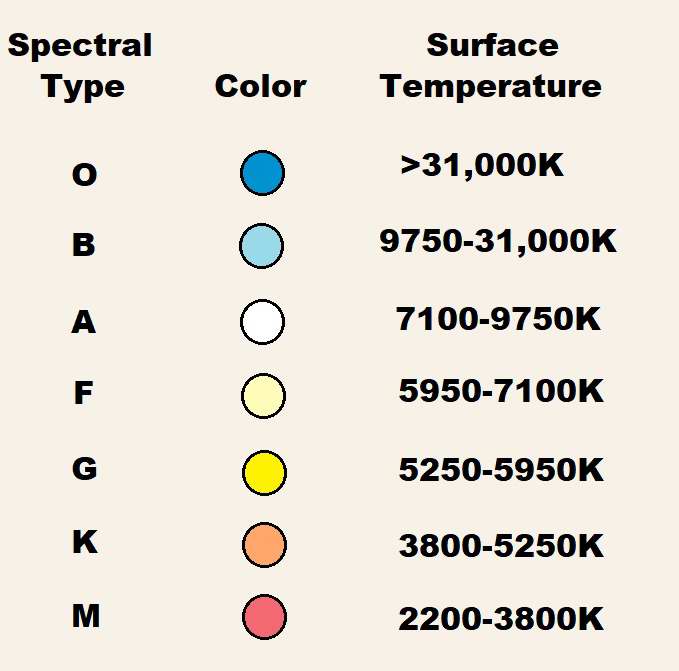 Stars come in more colors than just white, though that's what they look like to the casual observer. The reason
is they are not very bright and to understand why you must know some eye anatomy. Your retina which contains your
photoreceptor
cells has two types:
cones and
rods.
Your cones lie at the center of the
retina
whereas the rods are away from
the the center. Your cones are your color sensitive receptors whereas your rods are color blind. However, your rods are very
light sensitive whereas your cones are relatively insensitive. During the day (or in brightly lit areas) your
eye pupils are
contracted so that light only falls on the cones. But during the night (or in very dimly lit areas) your
eye pupils dilate which allows the light to fall on those very light sensitive rods. If you've ever wondered why color mostly disappears
as it gets dark even though you can still see, that is the reason. It is important that your eye pupils contract when things
are bright because it's generally painful if light falls directly on the rods.
Stars come in more colors than just white, though that's what they look like to the casual observer. The reason
is they are not very bright and to understand why you must know some eye anatomy. Your retina which contains your
photoreceptor
cells has two types:
cones and
rods.
Your cones lie at the center of the
retina
whereas the rods are away from
the the center. Your cones are your color sensitive receptors whereas your rods are color blind. However, your rods are very
light sensitive whereas your cones are relatively insensitive. During the day (or in brightly lit areas) your
eye pupils are
contracted so that light only falls on the cones. But during the night (or in very dimly lit areas) your
eye pupils dilate which allows the light to fall on those very light sensitive rods. If you've ever wondered why color mostly disappears
as it gets dark even though you can still see, that is the reason. It is important that your eye pupils contract when things
are bright because it's generally painful if light falls directly on the rods.
But for the brighter stars in the sky you can detect a little color. And you can enhance that by using binoculars and especially a telescope where they become much brighter so more light falls on your color sensitive cones. One great way to see star colors better is to observe Double Stars. Some of those double pairs have contrasting colors and they really bring out the colors. We have several of these listed in our section on Double Stars. At the right is one of the best examples: Albireo whose Bayer Designation is β Cygni. It is often referred to as the blue and gold double.
Star colors are given in astronomical catalogues by their spectral type. The major spectra classes are: O, B, A, F, G, K, and M. Within each of these they are further broken down with the possible numbers of 0-9. It is the spectra class that determines the star color and it also goes along with the surface temperature of the star. In the table temperature is given in degrees Kelvin.
Variable Stars
There are many stars in the sky that don't shine at a constant brightness and therefore vary. Aptly, these are called variable stars. For 110 years these stars have been observed by amateur astronomers making brightness measurements. These observations are reported to the American Association of Variable Star Observers (AAVSO) who combines all the estimates so they can be utilized by professionals.
Variable stars have their own naming system based on a variation of the Bayer format. The system is as follows:
- Stars with an existing Bayer name are not given a special designation. Examples: Mira, β Per
- Variable stars in a given constellation start by given a single letter: R-Z. Examples: R Ori, Z UMa
- Once those 9 letters are exhausted, it's continued with RR, RS, ... RZ, then SS, ST, ... SZ, TT, TU, ... TZ, ... ZZ. This gives another 45 possible designations. Examples: SS Cyg, YZ Cet
- Then it starts with AA, AB, ... AZ, BB, BC, ... BZ, ... CC, CD, ... CZ, ... QZ. The letter J is never used in either position. This adds another 280 designations. Examples: BC UMa, EE Ori
- After those 334 stars, start a numbering system with the letter "V" and a number appended starting at 335 so V335, V336, V337, ...
Note: When two letters are used, the second one is never less than the first. So names such as SR, ZT, CA, are not valid.
In the future we plan on writing more extensively on variable stars. But in the meantime if you want to learn more we suggest Variables: What Are They and Why Observe Them? and Types of Variable Stars: A Guide for Beginners by the AAVSO.
Multiple Star Systems
Here are the objects composed of two or more stars.
Double Stars
Many of the stars in the sky are actually double stars. We have a whole section on double stars which you can read here.
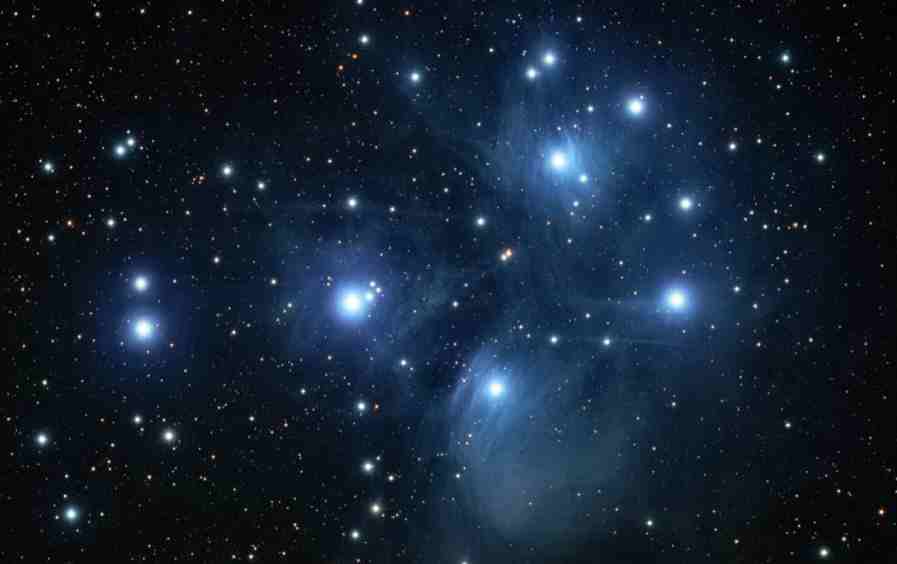
Open Star Clusters
An open cluster is a group of stars in close proximity that can number in the thousands. That proximity is not only what we see in the sky, but also in space where the stars are generally tied together by gravity.
At the right is an example of an open cluster. It's an image of M45 (the Pleiades) taken by a member of the MAS using our observatory equipment. Other examples are M44, M11, and M35
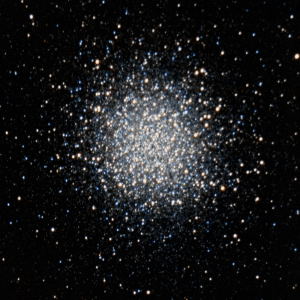
Globular Star Clusters
A globular cluster is a spherical collection of stars which are tightly bound by gravity which gives them their spherical shape. The density of stars increases going toward the center. These clusters are often simply referred to as globulars. All of the globular clusters we can readily see (i.e., in amateur telescopes) are within our own galaxy.
The image at the right shows an example of the globular cluster M13 (the Hercules Cluster) taken by a member of the MAS using our observatory equipment. Other examples are M3, and M4
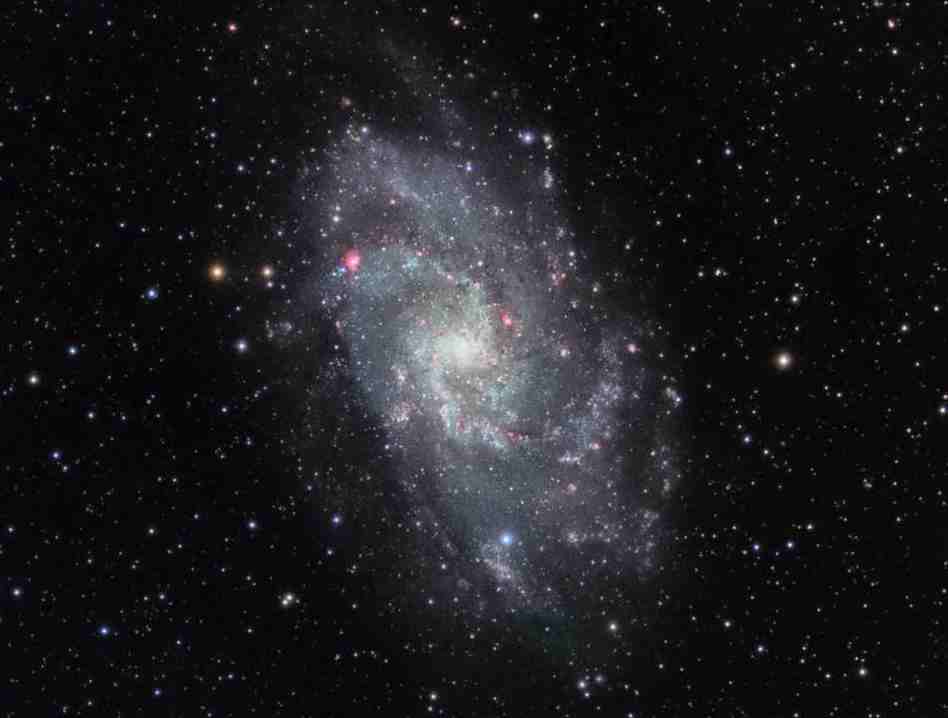 Galaxies
Galaxies
A galaxy is a huge collection of gas, dust, and billions of stars and their solar systems. Galaxies are often referred to as island universes. A galaxy is held together by gravity. At the core of nearly every galaxy is a supermassive black hole, and this includes our galaxy, the Milky Way. Spiral galaxies like the Milky Way actually spin around its center. The time it takes to make one full revolution is called a cosmic year. For our galaxy that's 200 million years. When you look up at stars in the night sky, you're seeing other stars in the Milky Way.
The image at the right is of M33, the Triangulum Galaxy taken by a member of the MAS using our observatory equipment. Other examples are M31 (Andromeda Galaxy), and M51 (Whirlpool Galaxy).
Dead Stars
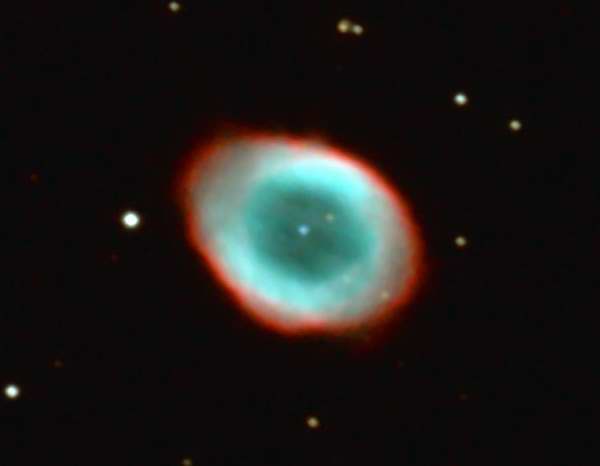 Planetary Nebula is a name given to a class of dying stars that don't go nova,
but after becoming
red giants
which expand to the point where they
finally collapse. They then eject a shell of gas which will last just tens of thousands of years having spread through space to the point where it's no longer visible.
The old star becomes a
white dwarf which illuminates the mostly ionized hydrogen that has been thrown out. It is expected that this will happen to our own
sun in about 5 billion years.
Planetary Nebula is a name given to a class of dying stars that don't go nova,
but after becoming
red giants
which expand to the point where they
finally collapse. They then eject a shell of gas which will last just tens of thousands of years having spread through space to the point where it's no longer visible.
The old star becomes a
white dwarf which illuminates the mostly ionized hydrogen that has been thrown out. It is expected that this will happen to our own
sun in about 5 billion years.
They get the name "planetary" because many of these are round like a planet.
The example at the right is M57, the Ring Nebula by a MAS member using our observatory equipment. At the center is the white dwarf which is illuminating the nebula. Other examples are the Helix Nebula, M27 (Dumbbell Nebula), and M1 (Crab Nebula).


